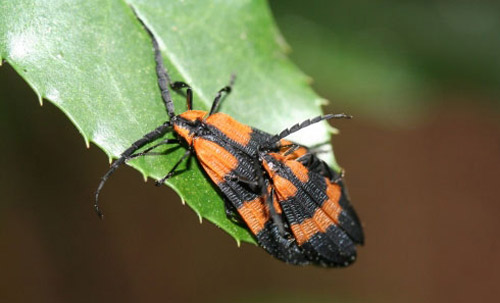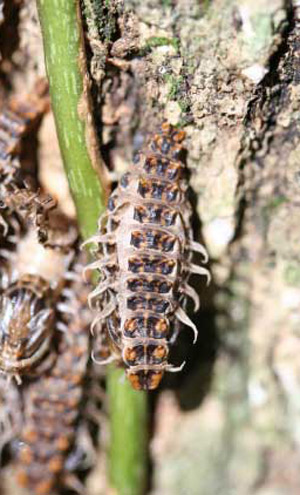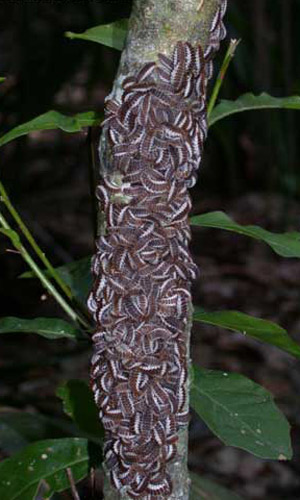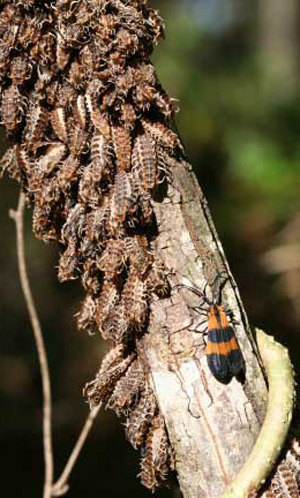common name: banded net-winged beetle
scientific name: Calopteron discrepans (Newman) (Insecta: Coleoptera: Lycidae)
Introduction - Distribution - Description - Life Cycle and Biology - Defenses - Selected References
Introduction (Back to Top)
The banded net-winged beetle, Calopteron discrepans (Newman), is a colorful black and orange net-winged beetle commonly found resting on vegetation in moist woods throughout much of the eastern United States.
Distribution (Back to Top)
Florida west to Texas and north to Manitoba and Québec (Evans 2014).
Description (Back to Top)
Adults: The adults range in length from approximately 10 to 15 mm. Males are smaller than females. The elytra have the elevated lengthwise ridges and cross ridges characteristic of most lycids and are orange with a median and a terminal black band (Figure 1).
Figure 1. Calopteron discrepans (Newman) adults mating. The smaller male is on top. Photograph by Donald W. Hall, Entomology and Nematology Department, University of Florida.
The banding patterns of Calopteron discrepans and the closely-related Calopteron reticulatum (Fabricius) are very similar in appearance. In Calopteron discrepans, the sutural extension of the median black band is expanded basally and is widest at the scutellum. Also, the metasternum and second antennal joint are totally black in Calopteron discrepans whereas the metasternum of Calopteron reticulatum is more or less rufous antero-medially, and the second antennal segment is fulvous or brown (Green 1952, Dillon and Dillon 1961).
A third sympatric species, Calopteron terminale (Say) usually lacks the median black band on the elytra, and the elytra when viewed from the side are wavy with a depression anterior to the apical band. If a median band is present in Calopteron terminale, it is not produced along the suture toward the bases of the elytra. Because of their similarity in appearance and variability of the banding patterns, the Calopteron species have often been misidentified.
Larvae: Larvae are black with burnt-orange patches (Figures 2, 3 and 4).
Figure 2. Calopteron discrepans (Newman) distended prepupal larva (dorsal view). Photograph by Donald W. Hall, Entomology and Nematology Department, University of Florida.
Figure 3. Calopteron discrepans (Newman) distended prepupal larva (ventral view). Photograph by Donald W. Hall, Entomology and Nematology Department, University of Florida.
Pupa:
Figure 4. Calopteron discrepans (Newman) pupa within last instar larval case. Photograph by Donald W. Hall, Entomology and Nematology Department, University of Florida.
Life Cycle and Biology (Back to Top)
Nothing is known of the egg stage and oviposition site of Calopteron species. Calopteron larvae are reported to live in rotten logs, under loose bark or, less commonly, in soil or leaf litter. Lycid larvae are reported to be predacious by some authors (Miller 1988, Triplehorn and Johnson 2005) whereas other authors (Lawrence 1991, Marshall 2006, McCabe and Johnson 1979, Withycombe 1926) report that they feed on myxomycetes, fungi, or fermenting plant juices.
Full-grown larvae of Calopteron species aggregate prior to pupation (McCabe and Johnson 1979, Moffat 1883, Withycombe 1926) (Figure 5).
Figure 5. Prepupation aggregation of larvae of Calopteron sp. Photograph by Lyle J. Buss, Entomology and Nematology Department, University of Florida.
These aggregations may ultimately contain hundreds of pupae packed together in shingled masses. The Calopteron discrepans aggregation pictured below (Figure 6) is part of a larger aggregation that contained over 600 pupae.
Figure 6. Calopteron discrepans (Newman) pupal aggregation and newly emerged adult. Photograph by Donald W. Hall, Entomology and Nematology Department, University of Florida.
Defenses (Back to Top)
Aposematic coloration: The integument of Calopteron larvae displays bright, contrasting coloration, and the larvae are likely distasteful. Pupation occurs within the last instar larval exoskeleton (Young and Fischer 1972). The exoskeletons which retain the bright larval coloration probably provide not only shelter but also aposematic (warning coloration) benefit to the pupae.
Aggregation of aposematic insects is generally believed to be adaptive as a defensive mechanism against predators (Riipi et al. 2001, Vulinec 1990), and that is the presumed benefit of the pre-pupation aggregation behavior of Calopteron.
Chemical defense: The colorful adults of Calopteron reticulatum have been shown to contain pyrazines (https://pubchem.ncbi.nlm.nih.gov/compound/pyrazine#section=Top) (Accessed October 30, 2016) (that likely impart the repugnant scent of the beetles) and lycidic acid and other fatty acids that may render them distasteful to predators (Eisner et al. 2005). The ridges on the wings are brittle and rupture easily releasing defensive chemicals. They also reflex-bleed from the leg joints when attacked (Evans 2014). Eisner et al. (2008) demonstrated that North American species of the lycid genera Lycus and Calopteron are rejected by thrushes (Hylocichla spp.), wolf spiders (Lycosa spp), and the orb-weaving spider Trichonephila clavipes (L).
Selected References (Back to Top)
- Dillon EA, Dillon LS. 1961. A Manual of Common Beetles of Eastern North America. Row, Peterson and Company. Evanston, Illinois. 884 pp.
- Eisner T, Eisner M, Siegler M. 2005. Secret Weapons: Defenses of Insects, Spiders, Scorpions, and Other Many-Legged Creatures. Harvard University Press. Cambridge, Massachusetts. 384 pp.
- Eisner T, Schroeder FC, Snyder N, Grant JB, Aneshansley DJ, Utterback D, Meinwald J, Eisner M. 2008. Defensive chemistry of lycid beetles and of mimetic cerambycid beetles that feed on them. Chemoecology 18: 109-119.
- Evans AV. 2014. Beetles of Eastern North America. Princeton University Press. Princeton, New Jersey. 560 pp.
- Green JW. 1952. The Lycidae of the United States and Canada. IV. The tribe Calopterini (Coleoptera). Transactions of the American. Entomological Society (Philadelphia). 78: 1-19.
- Lawrence JF. 1991. Lycidae (Cantharoidea), pp. 423-424. In Stehr FW. [editor] Immature Insects, Vol. 2. Kendall/Hunt Publishing Company. Dubuque, Iowa. 992 pp.
- Marshall SA. 2006. Insects. Their Natural History and Diversity. Firefly Books. Buffalo, New York. 720 pp.
- McCabe TL, Johnson LM. 1979. Larva of Calopteron terminale (Say) with additional notes on adult behavior (Coleoptera: Lycidae). Journal of the New York Entomological Society 87: 283-288.
- Miller RS. 1988. Behavior of Calopteron reticulatum (F.) larvae (Coleoptera: Lycidae) Ohio Journal of Science 88: 119-120.
- Moffat JA. 1883. Correspondence. Canadian Entomologist 15: 179-180.
- Riipi MR, Alatolo RV, Lindström L, Mappes J. 2001. Multiple benefits of gregariousness cover detectibility costs in aposematic aggregations. Nature (London) 413: 512-514.
- Triplehorn CA, Johnson NF. 2005. Borror and DeLong's Introduction to the Study of Insects. 7th edition. Thomson Brooks/Cole. Belmont, California. 864 pp.
- Vulinec K. 1990. Collective security: aggregation by insects as a defense, pp. 251-288. In Evans DL, Schmidt JO. [editors] Insect Defenses: Adaptive Mechanisms and Strategies of Prey and Predators. State University of New York Press. Albany, New York. 482 pp.
- Withycombe CL. 1926.The biology of lycid beetles in Trinidad. Proceedings of the Entomological Society of London. 1: 32-33.
- Young DK, Fischer RL. 1972. The Pupation of Calopteron terminale (Say) (Coleoptera: Lycidae). Coleopterists. Bulletin 26: 17-18.





